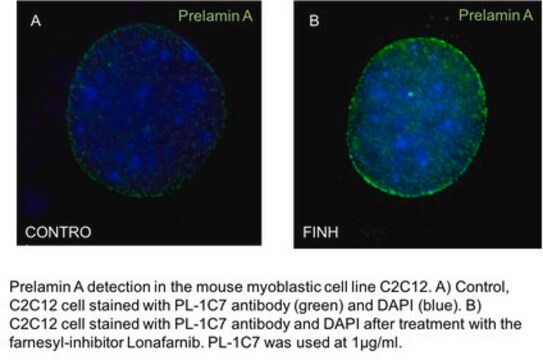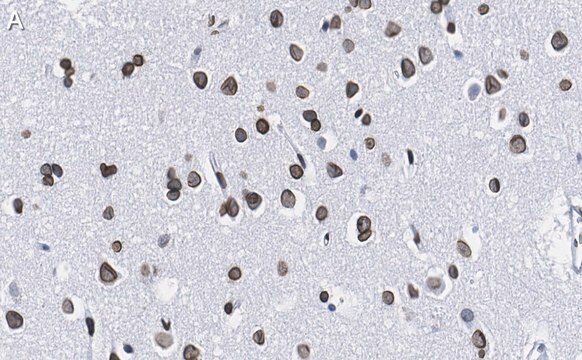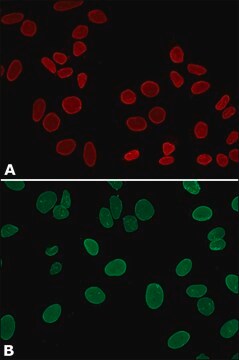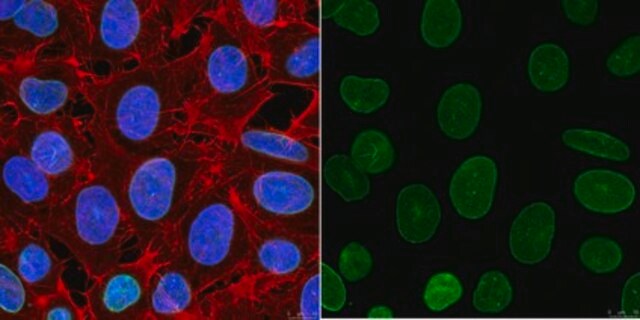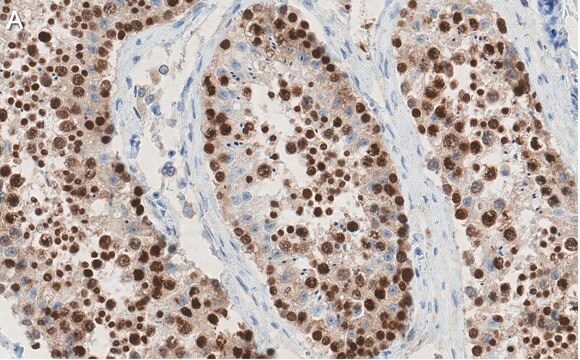MABT345
Anti-Prelamin-A Antibody, clone 7G11
clone 7G11, from rat
Sinônimo(s):
Prelamin-A/C, Prelamin-A, Lamin-A/C
About This Item
WB
western blot: suitable
Produtos recomendados
fonte biológica
rat
Nível de qualidade
forma do anticorpo
purified antibody
tipo de produto de anticorpo
primary antibodies
clone
7G11, monoclonal
reatividade de espécies
mouse
técnica(s)
immunofluorescence: suitable
western blot: suitable
Isotipo
IgG2aκ
nº de adesão NCBI
nº de adesão UniProt
Condições de expedição
wet ice
modificação pós-traducional do alvo
unmodified
Informações sobre genes
mouse ... Lmna(16905)
Descrição geral
Especificidade
Imunogênio
Aplicação
Cell Structure
Adhesion (CAMs)
Immunofluorescence Analysis: A representative lot detected upregulated prelamin-A immunoreactivity in keratinocytes, but not in dermal fibroblasts by fluorescent immunohistochemistry using paraformaldehyde-fixed and paraffin-embedded skin sections from keratinocyte-specific Fntb knockout mice, while prelamin-A upregulation was seen in both keratinocytes and dermal fibroblasts from mice with non-tissue/cell type-specific Zmpste24 knockout (Lee, R., et al. (2010). Hum. Mol. Genet.19(8):1603-1617).
Immunofluorescence Analysis: A representative lot stained the nuclear rim of hepatocytes by fluorescent immunohistochemistry using methanol-fixed and Tween-permeabilized frozen liver sections from a transgenic mouse strain that produces the C662S non-farnesylated prelamin-A only (nPLAO/nPLAO) and no lamin-C, while cellular prelamin-A level was undetectable in liver sections from wild-type mice or a mouse strain that produces wild-type prelamin-A only (PLAO/PLAO) and no lamin-C (Davies, B.S., et al. (2010). Hum. Mol. Genet. 19(13):2682-2694).
Western Blotting Analysis: A representative lot detected cellular prelamin-A accumulation upon farnesyltransferase inhibitor (FTI) treatment in murine fibroblasts. Clone 7G11 selectively detects prelamin-A, but not mature lamin-A or lamin-C (Lee, R., et al. (2010). Hum. Mol. Genet.19(8):1603-1617).
Note: Under normal condition, cellular prelamin-A level is below detection. Any newly produced prelamin-A is quickly processed further to yield mature lamin-A. Cellular farnesyltransferase and/or ZMPSTE24 activity must be inhibited (by gene knockout or inhibitor treatment) to allow antibody-based detection of cellular prelamin-A.
Qualidade
Western Blotting Analysis: 0.5 µg/mL of this antibody detected 2-day FTI-276 (5 µM; Cat. No. 344550) treatment-induced prelamin-A accumulation in murine RAW 264.7 macrophages.
Descrição-alvo
forma física
Armazenamento e estabilidade
Outras notas
Exoneração de responsabilidade
Não está encontrando o produto certo?
Experimente o nosso Ferramenta de seleção de produtos.
Código de classe de armazenamento
12 - Non Combustible Liquids
Classe de risco de água (WGK)
WGK 1
Ponto de fulgor (°F)
Not applicable
Ponto de fulgor (°C)
Not applicable
Certificados de análise (COA)
Busque Certificados de análise (COA) digitando o Número do Lote do produto. Os números de lote e remessa podem ser encontrados no rótulo de um produto após a palavra “Lot” ou “Batch”.
Já possui este produto?
Encontre a documentação dos produtos que você adquiriu recentemente na biblioteca de documentos.
Nossa equipe de cientistas tem experiência em todas as áreas de pesquisa, incluindo Life Sciences, ciência de materiais, síntese química, cromatografia, química analítica e muitas outras.
Entre em contato com a assistência técnica